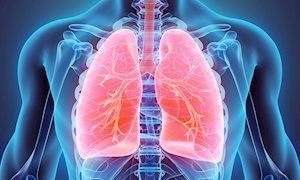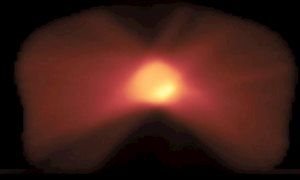24 July 2020
13,000 lung cancer diagnoses per year
Every year, approximately 13,000 people are diagnosed with lung cancer. Half of this group is already at an advanced stage, with metastases in other organs. Treatment is generally limited to inhibiting the disease progression and reducing symptoms. If the disease is only situated in the lungs, there are more treatment options, and the chance of recovery is higher. Early diagnosis is, therefore, vital. This sounds easier than it is; it is often difficult to see where the abnormalities are situated precisely and whether the lymph nodes around the lungs are already affected.
The navigation system will lead to the abnormalities
Researchers at the department of pulmonary diseases, in cooperation with Philips, have introduced a technique that uses the natural respiratory tract, allowing an outpatient treatment. This technique is called navigation bronchoscopy (in Dutch). This method looks a lot like a route map with navigation. The X-rays and CT scans of the lungs provide the physician with a 'road map' image of where they should go. The physician then inserts a tube – the bronchoscope – with a video camera through the patient's mouth. Through the natural airways, the bronchoscope is directed towards the abnormalities that have been identified. The scans help the specialist to navigate to the right site. The physician can also use a cone beam CT scan for microscopic abnormalities located deep in the lung, both before and during this procedure. This method continuously produces very accurate new images. This allows the physician to see that they have reached the abnormality, which is sometimes less than a centimeter in size.
At the same time, the method can be used to collect a tissue sample that can be tested immediately. Over the past three years, physicians have examined about 300 patients in this way. 90% of tests currently yield the correct diagnosis, the same score as for a biopsy but without any complications. What’s more, by using the natural airways it is now possible to access places that were previously difficult to reach or even unreachable.
Pneumothorax
Until now, diagnostics usually occurred by probing the abnormality with a needle through the chest (puncture) or via chest surgery, where a piece of tissue was obtained for further testing. Both methods are radical, with more than 20% of the cases resulting in pneumothorax or multiple-day hospitalization. Because of the risks, not everyone is eligible for a puncture, which sometimes leads to immediate treatment, sometimes without a confirmed diagnosis. There is room for improvement.
Erik van der Heijden: "In a third to half of all patients we operate on for lung cancer, the diagnosis is not confirmed. They undergo surgery because there is a suspicion of lung cancer. Others have radiation therapy or chemotherapy based on this suspicion. It would be much better if we could confirm a diagnosis so that we can treat those who need it as soon as possible, but don't treat people unnecessarily."
Also suitable for lymph nodes
This route via the natural respiratory tract can also be used to check for metastases in the lymph nodes around the lungs during the same procedure. This will make it easier to identify any metastases. Research (in collaboration with staff from Bologna, Florence, Amsterdam, Fano, Modena and Copenhagen) shows that the tougher the tissue, the higher the risk of abnormalities.
This knowledge allows for a better risk profile of the various lymph nodes. It lets the physician determine from which lymph nodes tissue samples should be collected for further testing. Erik van der Heijden: "These two studies can lead to a faster diagnosis, hopefully with a better treatment perspective. It improves the care we can provide and enables us to diagnose both the tumor and the lymph nodes more accurately. This opens new doors, and might even steer us in the direction of immediate treatment of patients. It would not be the first time a patient asked to remove the abnormality immediately while we were in there for the diagnosis anyway."
Publication in Respirology
Role of endobronchial ultrasound strain elastography in the identification of fibrotic lymph nodes in sarcoidosis: A pilot study
Rocco Trisolini, Roel L.J. Verhoeven, Alessandra Cancellieri, Annalisa De Silvestri, Filippo Natali, Erik H.F.M. Van der Heijden.

13,000 lung cancer diagnoses per year
Every year, approximately 13,000 people are diagnosed with lung cancer. Half of this group is already at an advanced stage, with metastases in other organs. Treatment is generally limited to inhibiting the disease progression and reducing symptoms. If the disease is only situated in the lungs, there are more treatment options, and the chance of recovery is higher. Early diagnosis is, therefore, vital. This sounds easier than it is; it is often difficult to see where the abnormalities are situated precisely and whether the lymph nodes around the lungs are already affected.
The navigation system will lead to the abnormalities
Researchers at the department of pulmonary diseases, in cooperation with Philips, have introduced a technique that uses the natural respiratory tract, allowing an outpatient treatment. This technique is called navigation bronchoscopy (in Dutch). This method looks a lot like a route map with navigation. The X-rays and CT scans of the lungs provide the physician with a 'road map' image of where they should go. The physician then inserts a tube – the bronchoscope – with a video camera through the patient's mouth. Through the natural airways, the bronchoscope is directed towards the abnormalities that have been identified. The scans help the specialist to navigate to the right site. The physician can also use a cone beam CT scan for microscopic abnormalities located deep in the lung, both before and during this procedure. This method continuously produces very accurate new images. This allows the physician to see that they have reached the abnormality, which is sometimes less than a centimeter in size.
At the same time, the method can be used to collect a tissue sample that can be tested immediately. Over the past three years, physicians have examined about 300 patients in this way. 90% of tests currently yield the correct diagnosis, the same score as for a biopsy but without any complications. What’s more, by using the natural airways it is now possible to access places that were previously difficult to reach or even unreachable.
Pneumothorax
Until now, diagnostics usually occurred by probing the abnormality with a needle through the chest (puncture) or via chest surgery, where a piece of tissue was obtained for further testing. Both methods are radical, with more than 20% of the cases resulting in pneumothorax or multiple-day hospitalization. Because of the risks, not everyone is eligible for a puncture, which sometimes leads to immediate treatment, sometimes without a confirmed diagnosis. There is room for improvement.
Erik van der Heijden: "In a third to half of all patients we operate on for lung cancer, the diagnosis is not confirmed. They undergo surgery because there is a suspicion of lung cancer. Others have radiation therapy or chemotherapy based on this suspicion. It would be much better if we could confirm a diagnosis so that we can treat those who need it as soon as possible, but don't treat people unnecessarily."
Also suitable for lymph nodes
This route via the natural respiratory tract can also be used to check for metastases in the lymph nodes around the lungs during the same procedure. This will make it easier to identify any metastases. Research (in collaboration with staff from Bologna, Florence, Amsterdam, Fano, Modena and Copenhagen) shows that the tougher the tissue, the higher the risk of abnormalities.
This knowledge allows for a better risk profile of the various lymph nodes. It lets the physician determine from which lymph nodes tissue samples should be collected for further testing. Erik van der Heijden: "These two studies can lead to a faster diagnosis, hopefully with a better treatment perspective. It improves the care we can provide and enables us to diagnose both the tumor and the lymph nodes more accurately. This opens new doors, and might even steer us in the direction of immediate treatment of patients. It would not be the first time a patient asked to remove the abnormality immediately while we were in there for the diagnosis anyway."
Publication in Respirology
Role of endobronchial ultrasound strain elastography in the identification of fibrotic lymph nodes in sarcoidosis: A pilot study
Rocco Trisolini, Roel L.J. Verhoeven, Alessandra Cancellieri, Annalisa De Silvestri, Filippo Natali, Erik H.F.M. Van der Heijden.
Related news items

KWF grant for better selection of individuals and lung nodules in lung cancer screening
1 November 2021 The Dutch Cancer Society has awarded the consortium project ‘Multi-source data approach for Personalized Outcome Prediction in lung cancer screening’ with a grant of 1,425,000 Euro. Colin Jacobs will lead the work package on using artificial intelligence for accurate risk estimation of lung nodules. go to page
Anti-tuberculosis drug can be safely dosed even higher
16 March 2021 A considerably higher dose of the anti-tuberculosis drug rifampicin is safe and can also lead to a shorter treatment for tuberculosis and less resistance. go to page
Radiation boost lowers risk of prostate cancer recurrence
21 January 2021 An additional external-beam radiation dose delivered directly to the tumor can benefit the prospects of men with non-metastatic prostate cancer, without causing additional side effects. The risk of relapse within five years for these men is smaller than for men who did not receive this boost. go to page
650,000 Euro funding for research into the phasing out of medication for leukaemia patients
30 July 2020 With a 650,000 euro funding from ZonMw, researchers from the Haematology and Pharmacy departments can develop a medication phasing out strategy for patients with chronic myeloid leukaemia. This strategy will be tested in practice. go to page
Optimizing workup in head and neck cancer (HNC)
23 July 2020 In the journal Cancer RIHS researcher Henrieke Schutte described the outcomes after the implementation of a fast-track multidisciplinary integrated HNC care program: time-to-treatment was significantly reduced and survival and patient satisfaction increased significantly without increasing costs. go to page
